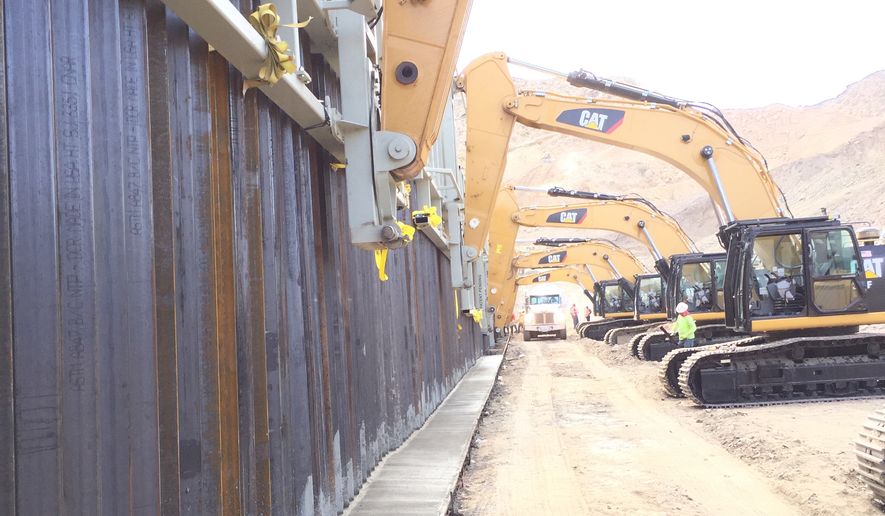A New Mexico town issued a cease-and-desist order Tuesday telling a private group building a half-mile of border wall to stop construction, saying We Build the Wall’s permits weren’t in order.
The group, which was 80% of the way done with the section of wall, has stopped work in order to solve the snafu with Sunland Park, said Kris Kobach, general counsel for We Build the Wall.
He sounded confident that the project will be completed, saying city inspectors had been out to the site during construction on Friday, and officials had given them the go-ahead to build, and to pay the permit fee later, when the person who sets the rate returns from time off.
“We were told go ahead and we could pay for the permit when he gets back from vacation,” Mr. Kobach told The Washington Times.
Construction began last week and was supposed to be completed early this week on the section of wall, which closes a gap in fencing between the Rio Grande on the east and Mount Cristo Rey to the west.
But Sunland Park’s mayor said Monday that the wall’s 18-foot height violates a city ordinance on the size of fencing, which can only be 6 feet.
SEE ALSO: First-ever private border wall built in New Mexico
Javier Perea also said inspectors knew about construction last week and tried to visit the site Thursday but were denied access. He said the organizers did come to get permit documents on Friday, but never turned in a survey or site plan, and gave “contradictory information.”
“At this point, it will be turned over to the courts,” the mayor said.
He admitted the situation was “brand new” for the town and said it implicates the international boundary and perhaps state and federal environmental laws, all of which will have to be settled.
Mr. Kobach didn’t question the town’s motives, but Brian Kolfage, the wounded veteran who’s president of We Build the Wall, did.
“What cartel paid off the Sunland Park City officials to lie and shut down our wall project?” he said on Twitter.
He also said they were facing pressure from New Mexico Gov. Michelle Lujan Grisham, who in a statement blasted the project as “nonsense.”
Mr. Kolfage said the wall is already working. He released a photo on Twitter showing what appears to be a group of migrants on the Mexican side approaching the wall.
“A group came down to cross and saw the wall, immediately turned around and went back up [the] mountain!” he tweeted.
Mr. Kobach said they applied for a permit last week, were told everything was in order, and the application would normally be granted immediately. But they were unable to pay their fee because the person who set the rate was out.
Mr. Kobach said they were told to go ahead and build, and they could pay later.
The organizers said the site of the private wall is owned by American Eagle Brick Company and has been in private hands since the 1880s, or before New Mexico was admitted as a state.
Mr. Kobach said because it was in private hands so early, it does not have a “Roosevelt Reservation,” which is a 60-foot easement running along much of the border that was put under federal jurisdiction by President Theodore Roosevelt in 1907.
The erection of a wall by a private group could be a new wrinkle in the border wall debate, which was roiled last week by a judge’s order halting President Trump’s emergency wall-building plans.
In this case, We Build the Wall used online crowdfunding to raise money and hired one of the companies that had built one of the prototypes of wall for Mr. Trump’s wall-building contest in 2017.
The new wall begins at the Rio Grande and runs up to the lower elevations of Mount Cristo Rey. The wall on the Texas side ends at the river, and there used to be a gap on the New Mexico side running from the river over to Mount Cristo Rey.
Two parking lots, one on the Mexican side and one on the U.S. side, with naught but a ditch to separate them, offered a convenient staging point for would-be migrants.
Mr. Kobach said agents have told him perhaps 100 migrants a night cross — but the bigger problem is that they would cross, gaining agents’ attention, then drug smugglers would use the distraction to run drugs through elsewhere in the gap.
A typical night could exceed $100,000 worth of drugs through the gap, he said.
Mr. Kobach said they’ve finished the wall along the lower part, but the 20% that’s unfinished is on the elevations of Mount Cristo Rey. He said they also have yet to finish the access road and sensor system, and have only installed four of the 10 planned light poles.
• Stephen Dinan can be reached at sdinan@washingtontimes.com.




Please read our comment policy before commenting.